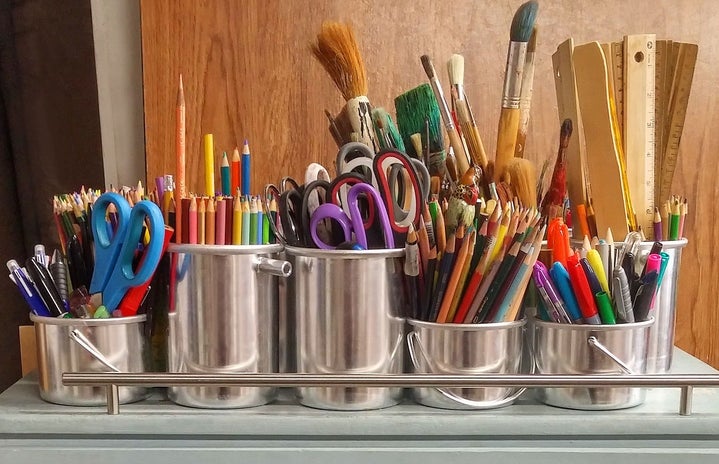This quarter, I went to LACMA’s sold out art exhibition Carne y Arena (Virtually present, Physically invisible). The exhibit was designed by Alejandro G. Iñárritu, the Academy Award-winning director, producer and screenwriter. Maybe you’ve seen some of his films like Birdman or The Revenant. After all, the whole world watched Leonardo DiCaprio win his first Oscar for his work with Iñárritu.
Now, Iñárritu has brought his talents to museum art: a virtual reality installation based off of true stories of immigrants as they tried to cross the border into the United States from Latin America. Carne y Arena is sold out until April, but I was lucky enough to experience it. There was no photography allowed in the exhibit, so I’ll try my best to retell my experience.
Right when I got to the area that the installation was being held, I had to sign a waiver form. When they handed me the clip board with the three pages worth of reading, I knew that this experience was going to be better than I could have even imagined. I actually read over all of the lists for journalistic purposes and just plain curiosity. I had to agree to take off my shoes and socks for the exhibit, walk on dirt/gravel and stay in an uncomfortably cold waiting room for a period of time. It specified that the experience was very immersive, and that I could stop it at any time by saying so. Not going to lie, the thought of needing a safe word to go through the installation made me just a bit nervous. After I signed the papers, a worker told me that the exhibition is a single person experience, meaning that I would go through all the stages by myself and that uncomfortableness of knowing I would be alone made me a bit more nervous.
When it was my turn to enter the installation, I walked through a thick black curtain into a completely dark room. The only light was from the glowing words describing Iñárritu’s design and purpose of the exhibit, and a very small window on the door I was to walk through next. In the dark room, I learned that Iñárritu interviewed several people who had crossed the border into the US, and had them reenact and describe to him what their different experiences were like. This let us know that these stories are authentic. The thought of going through something that I already anticipated to be overwhelming and scary, made me all the more nervous to know that this really happened to someone else. This idea of facing truth is what I think Iñárritu’s installation is all about.
After the dark room, I walked into a lighted room that was very, very cold. Keep in mind that I was wearing pants and a trench coat, and I was STILL cold. I can’t imagine how cold these “freezers” must have felt to the people that crossed wearing much less. In this room is where I had to remove my shoes and socks, and that made me feel extremely uncomfortable and vulnerable. The room was littered with tattered shoes and backpacks that a sign told me were collected from the desert were people attempt to cross from. Those shoes were completely in ruins compared to the Chucks I had in my hands. There was a very tiny pair of Crocs that stood out to me with Spongebob on them— something I’ve seen my little cousin wear.
After the cold room, I walked into another dark room where I came in contact with the gravel. This was the actual VR part of the installation. Everything that had came before was just to put me in the mentality that I was at: nervous, uncertain of the future and desperately following instructions because I didn’t know what else to do. All the feelings that people who have crossed the border probably felt as they made their journeys. A weighted backpack, headphones and VR goggles were put on me, and then the VR images started. I was in the middle of the desert, my feet stinging a little as I walked through the gravel. There was a family walking towards me, an older woman was being supported by two people because she had hurt her ankle. They walked right up to me, and I didn’t know what to do, so I tried to remain an observer and stay out of the way. Then I could hear the sound of helicopters, a bright light flashed on all of us and as I turned from the light, there were two police cars with guns and dogs both at the ready. There was screaming, crying and people being grabbed.
Then the scene turned into something different. There was peaceful music playing, it was actually the older woman singing, the family was seated at a dining table like all other families do for dinner. But we were still in the desert, just the lights and police were gone.That image faded away and I was again faced with yelling and pointed guns. The family and the older woman were being handcuffed and put in the backseats of the police cars. Needless to say, I think I have a fear of guns. My hands were shaking. At the height of the yelling, a police officer turned to me with his gun pointed and told me to “put my hands up.” I looped them through my backpack straps, confused because I thought I was only a bystander. But it was like he could see me, standing there, doing nothing but watching. He fired his gun, and the screen went black. My hands were still shaking. The final scene was the desert again, but it was empty— just me on the dirt. There was a trash bag floating softly through it. But, I was completely alone. Then the simulation was over and I was relieved of the gear.
I got to put my shoes back on, which is very hard to do when you feel like you can’t control your hands. I went into another dark room with more light up screens. I was relieved when I finally came in contact with real-life people for the first time in what seemed like forever. There were nine video-portraits on the wall, each detailing the different crossing experiences of the people they showed. Their eyes were always level with mine, I felt like they could actually see me. Maybe even see through me. There are nine different scenarios that a person could get when they enter the VR simulation, each one correlated to the story of one of the people in the portraits. The third portrait was from the first undocumented student to graduate from UCLA’s Law School. All of the stories hurt to read, but this one hit so close to home for a student that currently attends UCLA. I thought about all that I had to do at a young age to get to UCLA, and then I thought about all that he had to do in his life to get there. It makes my journey and the determination and dedication look like nothing at all. My hands didn’t stop shaking until I was half way down Wilshire Boulevard on my way back home.
I have never had an experience like this in my entire life. And if you’re wondering, yes, my hands are shaking as I write this. We always talk about what it would be like to be in someone else’s shoes, but we never actually put ourselves there. We usually hide from it. Ignorance is bliss, right? But ignorance is also dangerous. Understanding and facing the truth is a hard and scary thing to do for most people, but if we no longer want to be blind to the world around us, then we’ll have to face it one day. This installation shows the truth of what it’s like for people to cross into the US. People that have dreams, ambitions, determination, hopes of a brighter future for their families. People that have risked their lives simply to come here and work so that they can send money back to their families that haven’t crossed, that desire to make a difference in the world, be accepted into society, be treated like a human being.
We all want the same thing. I think that’s easy to forget, but more important to remember, and Iñárritu’s exhibit offers a chance to do just that.
Photos courtesy of Aubrey Freitas.



